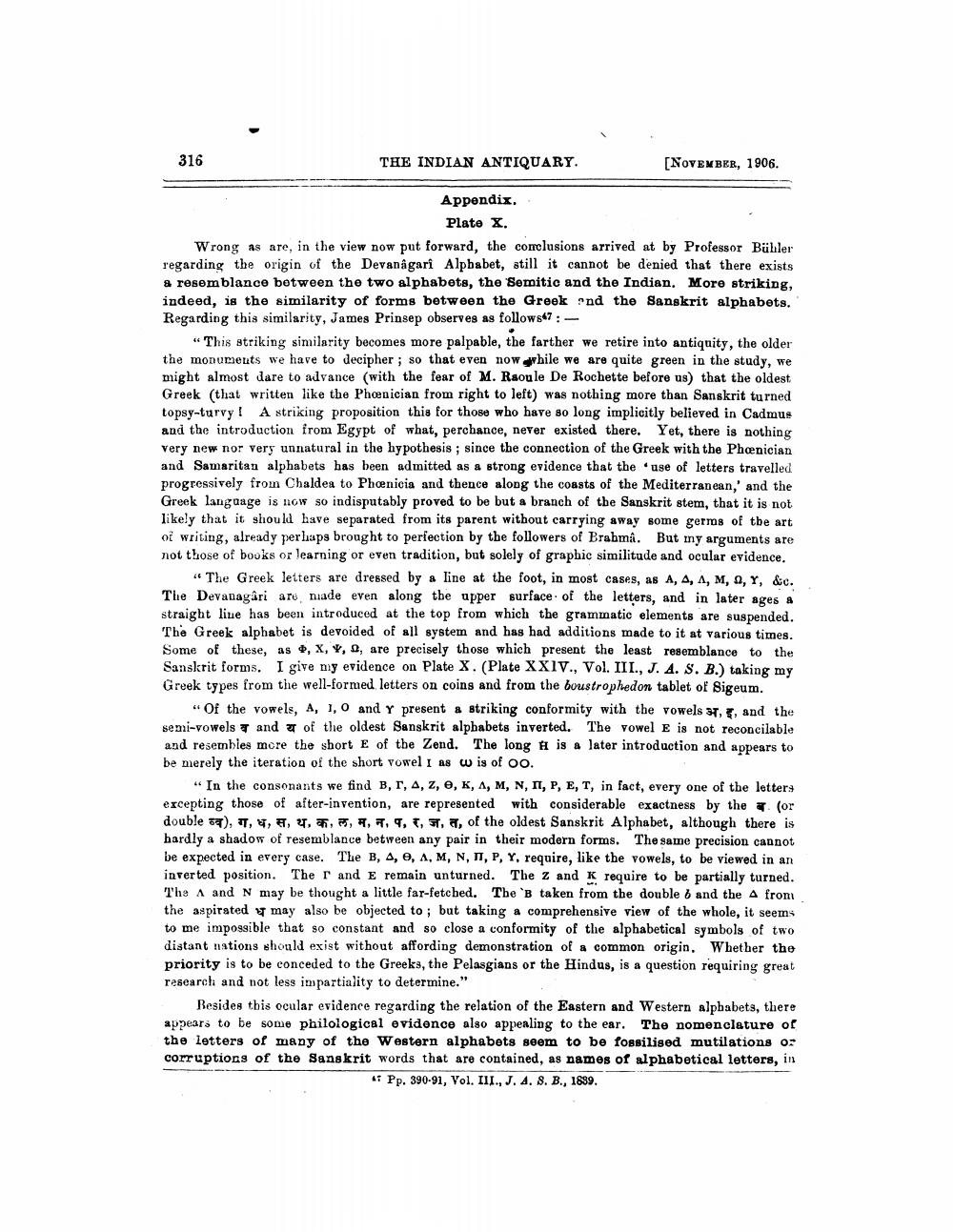________________
316
THE INDIAN ANTIQUARY.
[NOVEMBER, 1906.
Appendix,
Plate X. Wrong as are, in the view now put forward, the conclusions arrived at by Professor Bühler regarding the origin of the Devanagari Alpbabet, still it cannot be denied that there exists & resemblance between the two alphabets, the Semitic and the Indian. More striking, indeed, is the similarity of forms between the Greek and the Sanskrit alphabets. Regarding this similarity, James Prinsep observes as follows47:
“This striking similarity becomes more palpable, the farther we retire into antiquity, the older the monuments we have to decipher; so that even now while we are quite green in the study, we might almost dare to advance (with the fear of M. Raoule De Rochette before us) that the oldest Greek (that written like the Phoenician from right to left) was nothing more than Sanskrit turned topsy-turvy! A striking proposition this for those who have so long implicitly believed in Cadmus and the introduction from Egypt of what, perchance, never existed there. Yet, there is nothing very new nor very unnatural in the hypothesis ; since the connection of the Greek with the Phænician and Samaritan alphabets has been admitted as a strong evidence that the use of letters travelled progressively from Chaldea to Phoenicia and thence along the coasts of the Mediterranean,' and the Greek language is now so indisputably proved to be but a branch of the Sanskrit stem, that it is not likely that it should have separated from its parent without carrying away some germs of the art of writing, already perhaps brought to perfection by the followers of Brahma. But my arguments are not those of books or learning or even tradition, but solely of graphic similitude and ocular evidence.
- The Greek letters are dressed by a line at the foot, in most cases, as A,A,A, M, Q, Y, &c. The Devanagari are niade even along the upper surface of the letters, and in later ages a straight line has been introduced at the top from which the grammatic elements are suspended. The Greek alphabet is devoided of all system and has had additions made to it at various times. Some of these, as , X, Y, , are precisely those which present the least resemblance to the Sanskrit forms. I give my evidence on Plate X. (Plate XXIV., Vol. III., J. A. S. B.) taking my Greek types from the well-formed letters on coins and from the boustrophedon tablet of Sigeum.
* Of the vowels, A, I, O and y present a striking conformity with the vowels sp, , and the semi-vowels 7 and 3 of the oldest Sanskrit alphabets inverted. The vowel E is not reconcilable and resembles more the short E of the Zend. The long H is a later introduction and appears to be merely the iteration of the short vowel 1 as w is of oo.
"In the consonants we find B, C, A, C, E, K, A, M, N, N, P, E, T, in fact, every one of the letters excepting those of after-invention, are represented with considerable exactness by the for double a), T, , , , , , , , , , , , of the oldest Sanskrit Alphabet, although there is hardly a shadow of resemblance between any pair in their modern forms. The same precision cannot be expected in every case. The B, A, E, A, M, N, O, P, Y. require, like the vowels, to be viewed in an inverted position. The r and E remain unturned. The 2 and K require to be partially turned. The A and N may be thought a little far-fetched. The 'B taken from the double 6 and the A from the aspirated may also be objected to; but taking a comprehensive view of the whole, it seems to me impossible that so constant and so close a conformity of the alphabetical symbols of two distant nations should exist without affording demonstration of a common origin. Whether the priority is to be conceded to the Greeks, the Pelasgians or the Hindus, is a question requiring great research and not less impartiality to determine."
Besides this ocular evidence regarding the relation of the Eastern and Western alphabets, there appears to be some philological evidence also appealing to the ear. The nomenclature of the letters of many of the Western alphabets seem to be fossilised mutilations o: corruptions of the Sanskrit words that are contained, as names of alphabetical letters, in
* Pp. 390-91, Vol. III., J. A. 8. B., 1899.




